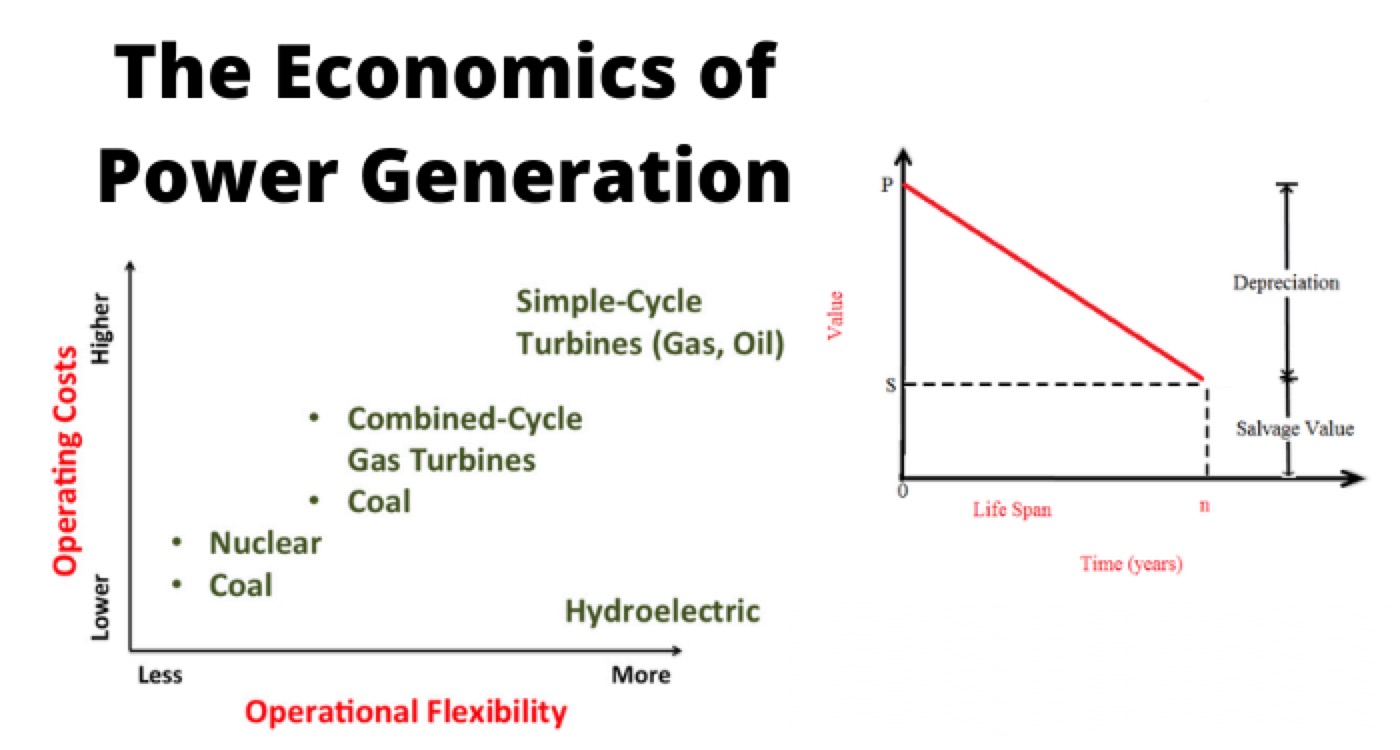Economics of Power Generation

Economics of Power Generation
In all new engineering enterprises of this era, the question of cost is of utmost importance. It is the role played by an engineer to achieve the desired technical result, with minimum cost that distinguishes him from a non engineer who can also possibly attain the same result, but at what cost? In a power generation industry we are usually confronted with a situation where we have to make a choice between equipment of high cost with high efficiency and their low cost counterpart with lower efficiency. In the first case, the charges due to interest and depreciation will be higher with lower energy bill as compared to the corresponding figures in the second case.
Here the role of the Electrical Engineer comes into play, where he has to balance the situation in such a way that the total expenditure of the plant is minimum, and thus the study of economics of power generation is of prime importance, taking all practical purposes into consideration.
To deduce the power generation economics effectively we should know the structure of annual expenditure of the plant and the factors affecting them. The total annual expenditure of the plant can be classified into several subheadings namely,
Fixed Charges
Semi fixed Charges
Running Charges
These are all important parameters pertaining to the Economics of power generation and are considered in details below.
Fixed Charges of Power Generation
Fixed charges, as the name suggest does not vary either with the capacity of the plant or with plant operation. These costs remain fixed under all circumstances. These mainly include the salaries of higher officials of the central organization and the rent of the land reserved for future expansion.
Semi Fixed Charges of Power Generation
These charges mainly depend on the installed capacity of the plant and are independent of the electrical energy output of the plant. These charges include the following :
Interest and depreciation on the capital cost of the generating plant, transmission and distribution network, buildings and other civil engineering works etc. Capital cost of the plant also includes the interest paid during the construction of the plant, salaries of engineers and other employees, development and construction of the power station. It also includes cost incurred on account of transportation, labor etc. to bring the equipment on site and installing the same, all of which are involved for the overall economics of power generation.
It is particularly note worthy, that in nuclear stations the capital cost of the station also includes the cost of initial charges of the nuclear fuel minus the salvage value paid at the end of its useful life.It also includes all types of taxes, insurance premiums pain on policies to cover the risk of accidental breakdown.
Rent paid for the land being actually used for the construction purpose.
The cost due to starting and shutting down of plants are also included in this category, when the power plant operates on one or two shift basis.
Running Charges of Power Generation
The running charges or running cost of a power plant, is probably one of the most important parameters while considering the economics of power generation as it depends upon the number of hours the plant is operated or upon the number of units of electrical energy generated. It essentially comprises of the following costs incurred mentioned below.
Cost of the fuel delivered coupled with the fuel handling cost in the plant. Coal is the fuel used in a thermal power plant, and diesel oil in case of a diesel station. In case of a hydro-electric plant there is no fuel cost as water is the free gift of nature. But a hydro-plant requires higher installation cost and their mega Watt output of power generation is also lower compared to the thermal power plants.
Wastage of the operational and maintenance stuff and salaries of supervisor staffs engaged in running the plant.
In case of a thermal power plant, power generation economics includes the cost of feed water for the boiler, like the cost of water treatment and conditioning.
As the amount of wear and tear of the equipment depends on the extent to which the plant is being used, so the lubricating oil cost and repair and maintenance charges of the equipment are also included in the running charges.
So, we can conclude saying, that the total annual charges incurred in the power generation, and the overall power generation economics can be represented by the equation,
Where ‘a’ represents the total fixed cost of the plant, and has no relation with the total output of the plant or the number of hours for which the plant is running.
‘b’ represents the semi-fixed cost, which mainly depends on the total output of the plant and not on the number of hours for which the plant is being operated. The unit for ‘b’ is thus ideally chosen to be in k-Watt.
‘c’ essentially represents the running cost of the plant, and depends on the number of hours for which the plant is running to generate a certain mega watt of power. Its unit is given in K-Watt-Hr.
Statement: Respect the original, good articles worth sharing, if there is infringement please contact delete.
Electrical Operations provides detailed insights into safe and efficient electrical procedures, guiding practitioners through every step of handling electrical systems.














